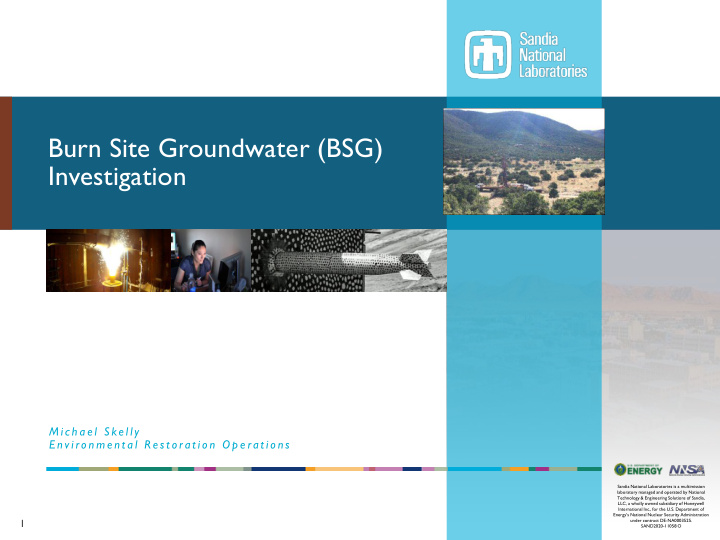



Burn Site Groundwater (BSG) Investigation M i c h a e l S ke l l y E n v i ro n m e n t a l R e s t o ra t i o n O p e ra t i o n s Sandia National Laboratories is a multimission laboratory managed and operated by National Technology & Engineering Solutions of Sandia, LLC, a wholly owned subsidiary of Honeywell International Inc., for the U.S. Department of Energy’s National Nuclear Security Administration 1 under contract DE-NA0003525. SAND2020-11058 O
BSG Site Description 2 ▪ The BSG Area of Concern is located in Lurance Canyon. ▪ In a remote area of the Manzanita Mountains. ▪ Lurance Canyon is a west-flowing drainage deeply incised into Paleozoic and Precambrian bedrock in moderately- to heavily-wooded pinon-juniper forest. ▪ SNL activities at the Burn Site testing area began in 1967; early site test activities included explosives testing, current use is fire-survivability studies (i.e., burn testing). ▪ Corrective action is required only for the groundwater in the BSG AOC. ▪ Groundwater occurs in Precambrian fractured bedrock that is recharged by infiltration of precipitation; flow is controlled by changes in rock type and faults/fractures.
BSG Groundwater Monitoring 3 ▪ Groundwater monitoring began in 1996. ▪ Depth to groundwater ranges from 45 to 360 feet below ground surface and groundwater flows to the west. ▪ The monitoring network consists of 16 monitoring wells and an inactive production well, with 4 wells installed in October/November 2019.
Conceptual Site Model for the BSG AOC 4
BSG Groundwater Monitoring 5 ▪ Groundwater is contaminated with nitrate at concentrations slightly above the maximum contaminant level (MCL). ▪ Nitrate has been detected above the MCL in several of the wells that are sampled. ▪ The plume is approximately 60 acres. ▪ Groundwater in the area is not used for any purpose; no one is drinking contaminated groundwater. ▪ The nearest downgradient drinking-water supply well (KAFB-4) is 8.4 miles to the west. ▪ Nitrate is typically derived from both man-made and natural sources, and may include ammonium nitrate slurry, wastewater discharges, and degradation of explosive compounds. ▪ No other chemicals exceed the MCL. Constituent of Maximum Concentration MCL Concern in 2019 40.3 milligrams per liter 10.0 milligrams per Nitrate (well CYN-MW9) liter
6 Potentiometric Surface Map October/November 2019
Current Status and Recent Activities 7 ▪ Completing characterization of the nature and extent of nitrate contamination before resuming the corrective action process and proposing alternatives for a remedy. ▪ Performed quarterly water level measurements and quarterly or semiannual groundwater sampling that was presented in the Annual Groundwater Monitoring Report submitted to the New Mexico Environment Department (NMED) in June 2020 (approved by NMED in August 2020). ▪ Recommendations for future characterization were submitted to the NMED in June 2018; and NMED responded in June 2018 requesting four wells. ▪ Submitted a Monitoring Well Installation Work Plan to NMED in January 2019; and approved by NMED in February 2019. ▪ Wells installed in October/November 2019. ▪ Submitted a Monitoring Well Installation Report to NMED in May 2020; and approved by NMED in July 2020. ▪ Met with NMED in September 2020 to discuss recent groundwater data.
Recommend
More recommend